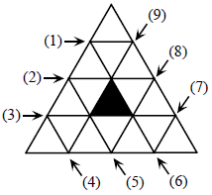- 翰林提供学术活动、国际课程、科研项目一站式留学背景提升服务!
- 400 888 0080
2000COMC加拿大数学公开赛真题答案免费下载
历年 Canadian Open Mathematics Challenge加拿大数学公开赛
真题与答案下载

翰林国际教育全网首发
力争超快速发布最全资料
助你在升学路上一帆风顺
为你
千千万万遍
真题下载请前往【纯真题】小程序
2000 COMC真题答案免费下载
共计2.5小时考试时间
此套试卷由两部分题目组成
Part A共8题,每题5分
Part B共4题,每题10分
共计12题,满分80分
不可使用任何计算器
完整版下载链接见文末
部分真题预览:
Part A Solutions:
A2) The terms in the sequence are paired, by combining each odd-numbered term with the next term (that is, we combine terms 1 and 2, 3 and 4, 5 and 6, etc).
The sum of each of these pairs is 9.
So we need 20 of these pairs to reach a sum of 180.
Thus we need 2 × 20 or 40 terms.
ANSWER: 40
Part B Solutions:
B3)
- We first consider Alphonse’s possible moves to begin the game. We can assume, without loss of generality, that he cuts on the left side of the black triangle.
- Case 1:Alphonse removes two white triangles, leaving
 .
.
In this case, Beryl removes only one white triangle, and passes the shape back to Alphonse, forcing him to remove the last white triangle and lose.
back to Alphonse, forcing him to remove the last white triangle and lose. - Case 2:Alphonse removes one white triangle only, leaving
 .
.
Beryl removes both of the white triangles on the right, leaving Alphonse in the same position as in Case 1 for his second turn.
Therefore Beryl can always win, regardless of Alphonse’s strategy.
- Case 1:Alphonse removes two white triangles, leaving
- We show that, again, Beryl always has a winning strategy.
The strategy is to reduce the shape in Figure 2 to the shape in Figure 1, and to have Alphonse make the first cut at this stage. Beryl also knows that if she is forced into a position of being the first to cut when Figure 2 is reduced to Figure 1, then Alphonse can force her to lose.
We number the lines on the diagram for convenience.

We can assume without loss of generality (because of symmetry) that Beryl cuts along (1), (2) or (3) to begin.
If she cuts (2) or (3), then Alphonse cuts the other of these two and leaves Beryl with Figure 1, where she will lose.
Therefore Beryl cuts (1) to begin.
If Alphonse now cuts (2) or (3), Beryl cuts the other of these two and passes the shape in Figure 1 back to Alphonse, and so he loses.
If Alphonse cuts (8) or (9), Beryl cuts the opposite and passes the shape in Figure 1 to Alphonse, and so he loses. (Similarly, if he cuts (5) or (6)).
So assume that Alphonse cuts (4) or (7), say (4) by symmetry.
If Beryl now cuts any of (2), (3), (5), (6), (8), or (9), then Alphonse can force Beryl to lose, in the same way as she could have forced him to lose, as above. So Beryl cuts (7).
Now Alphonse is forced to cut one of (2), (3), (5), (6), (8), or (9), and so Beryl makes the appropriate cut, passing the shape in Figure 1 back to Alphonse, and so he must lose.
Therefore Beryl always can have a winning strategy.
完整版真题资料可以底部二维码免费领取↓↓↓
站内搜索
竞赛真题免费下载(点击下载)
在线登记
最新发布
© 2024. All Rights Reserved. 沪ICP备2023009024号-1





